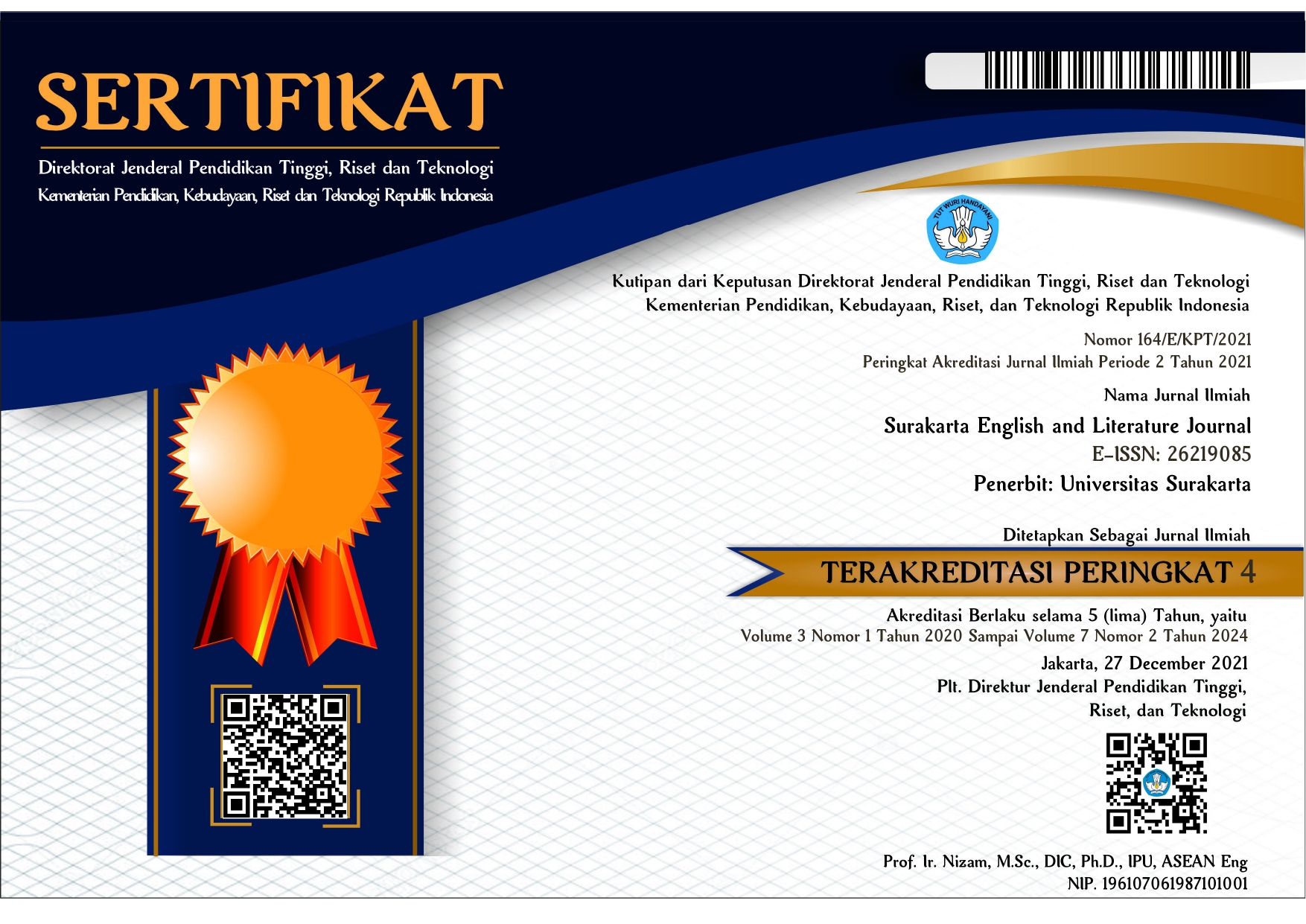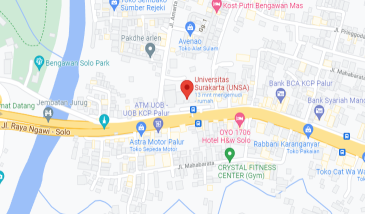The Use of Politeness Strategy and The Influence Factors in Political Talk Show
DOI:
https://doi.org/10.52429/selju.v7i1.214Keywords:
politeness strategy, Mata Najwa, political talk showAbstract
Maintaining etiquette in speech acts is a part of politeness strategies conducted in communication. This study aimed to describe the use of politeness strategies and the influence factors found in the political talk show of Mata Najwa. The research method employed a descriptive qualitative one as proposed by Brown and Levinson’s four politeness strategies. Face is indicated as an inherently political element in the theory of Goffman. The data is a dialogue transcription taken from Mata Najwa YouTube.on 18 October 2023. The techniques of collecting data were documentation by watching, listening, transcribing, reviewing the transcription, and selecting the speakers’ utterances. The data analysis involved identifying, and classifying utterances based on politeness strategies, analyzing frequency, interpreting the data, and drawing conclusions. The analysis of 193 utterances showed that 114 of them had positive politeness strategy data (59%), 34 had bald-on politeness strategy data (17,6%), 24 had negative politeness strategy data (12,4%), and 21 had off-record politeness strategy data (17,6%). The positive politeness method is the most commonly employed tactic. It suggests that the inclination toward familiarity between speakers and listeners as well as the sentiment to reveal people's individuality by lowering FTA in each phrase is generated by particular factors. That becomes a point for speakers to build and maintain relationships.
References
Alamsyah, A., Srikandi, C. N., & Hasnah, Y. (2023). Politeness Strategy to Portray Positive and Negative Face Responses in Vladimir Putin’s Speech on “ The Reason Why Russian Attacked. English Teaching and Linguistics Journal (ETLiJ), 4(2), 154–163.
Amalia, N. I., Indah, R. N., & Bahtiar, J. Y. (2023). Representation of Power through Politeness Strategies in Bridgerton Season 1 Movie. Elsya : Journal of English Language Studies, 5(3), 385–397. https://doi.org/10.31849/elsya.v5i3.14131
Astia, I. (2020). Politeness Strategy in Interlanguage Pragmatics of Complaints by International Students. IJELTAL (Indonesian Journal of English Language Teaching and Applied Linguistics), 4(2), 349. https://doi.org/10.21093/ijeltal.v4i2.528
Azzahra, U. A., Pratama, H., & Saleh, M. (2023). Politeness Strategies Used by Trump and El-Sisi in Their Speeches at United Nations Assembly. English Education Journal, 13(1), 12–19. https://doi.org/10.15294/eej.v13i1.68280
Batubara, M. H., Rahila, C. D. I., & Fitri, H. (2022). An Analysis Of Politeness Strategies Used By Donald Trump And Hillary Clinton Presidential Debate 2016. Journal of Linguistics, Literature, and Language Teaching (JLLLT), 1(2), 51–58. https://doi.org/10.37249/jlllt.v1i2.320
Borris, D., & Zecho, C. (2018). Linguistic politeness having seen in the current study issue. Linguistics and Culture Review, 2(1), 32–44. https://doi.org/10.37028/lingcure.v2n1.10
Brown, P., & Levinson, S. C. (1988). Politeness: Some Universals in Language Usage. In John J. Gwnperz (Ed.), TESOL Quarterly (Second, Vol. 22, Issue 4). Cambridge University Press. https://doi.org/10.2307/3587263
Cutting, J. (2002). Pragmatics and Discourse (P. Stockwell (ed.); 1st ed.). Routledge.
Dewanti, A. (2007). An analysis of grammatical errors in writing narrative texts done by the second-semester students at the Diploma Program English Department in Airlangga University Surabaya. Anglicist, 03, 1–7. https://ejournal.stkipmpringsewu-lpg.ac.id/index.php/smart/article/view/118/69
Duskaeva, L. (2021). Speech etiquette in Slavic online communities. In Speech Etiquette in Slavic Online Communities. https://doi.org/10.1007/978-3-030-81747-3
Fitriyani, S., & Andriyanti, E. (2020). Teacher and Students’ Politeness Strategies in EFL Classroom Interactions. IJELTAL (Indonesian Journal of English Language Teaching and Applied Linguistics), 4(2), 259. https://doi.org/10.21093/ijeltal.v4i2.473
Goffman, E., & Deeb, T. (1955). On Face-Work: An Analysis of Ritual Elements in Social Interaction. Psychiatry, 18(3), 213–231. https://doi.org/https://doi.org/10.1080/00332747.1955.11023008
Hartati, M. (2021). An Analysis Of Politeness Strategies In Sule’s Podcast. Jimedu, 1(November), 1–14. http://jurnalmahasiswa.umsu.ac.id/index.php/jimedu
Haryanto. (2017). The Analysis of Teacher’s Directive Expression in English Teaching Classes. Diponegoro University.
Haryanto, H., & Mubarok, H. (2018). Teacher’s Directive Expressions Analysis in English Teaching Classes. Lensa: Kajian Kebahasaan, Kesusastraan, Dan Budaya, 8(1), 22–42. https://doi.org/10.26714/lensa.8.1.2018.22-42
Hutahaean, D. T., Herman, H., & Girsang, A. F. F. (2021). An Analysis of Politeness Strategies Found in Pesbukers Variety Show. Wanastra: Jurnal Bahasa Dan Sastra, 13(1), 39–46. https://doi.org/10.31294/w.v13i1.9218
Indahsari, V. A., & Surjowati, R. (2021). Politeness Strategies Used in Mata Natjwa Program; Cipta kerja: Mana Fakta Mana Dusta. Linguistics and Literature, 4(1), 10–20.
Irawanto, B. (2019). Making it Personal : The Campaign Battle on Social Media in Indonesia’s 2019 Presidential Election. Perspective, 1(28), 1–11. https://www.iseas.edu.sg/images/pdf/ISEAS_Perspective_2019_28.pdf
Isabella, R. A., Munthe, E. J. B., Sigalingging, D. J. N., & Purba, R. (2022). LEARNING HOW TO BE POLITE THROUGH A MOVIE: A CASE ON BROWN AND LEVINSON’S POLITENESS STRATEGIES. Indonesian EFL Journal, 8(2), 147. https://journal.uniku.ac.id/index.php/IEFLJ/index154.https://doi.org/10.25134/ieflj.v8i2.6438
Kendenan, E. S., Kristen, U., & Wacana, S. (2023). An Analysis of Politeness Strategy Used by The Actors of Johnny English Film and Its Translation. Teknosastik Jurnaal Bahasa Dan Sastra, 21(2), 102–109.
King, R. D., & Wardhaugh, R. (1970). Introduction to Linguistics. American Speech, 45(3/4), 285. https://doi.org/10.2307/454846
Kristyaningsih, N., & Arifin, A. (2022). Politeness Strategies in Freedom Writers Movie. Salience Journal, 2(2), 77–84. https://jurnal.stkippgriponorogo.ac.id/index.php/Salience77
Kusumarini, I., Simpen, I. W., Budiarsa, M., & Laksana, I. (2021). Politeness Strategy of Japanese Hotel Staff in Bali. The International Journal of Language and Culture, 3(01), 9–28. https://www.growingscholar.org/journal/index.php/TIJOLAC/article/view/98
Lakoff, R. (1975). Language and Societies Language and Societies. 637–657.
Leech, G. (1980). Exploration in Semantics and Pragmatics. 133.
Levinson, S. (1992). Pragmatic. Cambridge University Press.
Marpudianto, K. (2020). Positive Politeness Strategies Used By David Muir And Donald Trump On “Abc News” And “Charlie Rose Show.” Jurnal Etnolingual, 4(1), 54–73. https://doi.org/10.20473/etno.v4i2.21312
Miles, M. B., Huberman, A. M., & Saldana, J. (2014). Qualitative Data Analysis: A Method Sourcebook. In SAGE Publications, Inc (Vol. 59, Issue December).
Mills, N. (2011). Situated learning through social networking communities: The development of joint enterprise, mutual engagement, and a shared repertoire. CALICO Journal, 28(2), 345–368. https://doi.org/10.11139/cj.28.2.345-368
Okamoto, S. (2010). Politeness in East Asia. In Interpersonal Pragmatics. https://doi.org/10.1515/9783110214338.1.71
Purwanto, S., & Soepriatmadji, L. (2013). Politeness Strategies in Model Conversations in English Textbooks. Parole, 3(1987), 75–84. https://ejournal.undip.ac.id/index.php/parole/article/view/2476
Rababah, M., Zoubi, S. Al, Masri, M. Al, Rababah, M., Zoubi, S. Al, & Masri, M. Al. (2021). Association of Arab Universities Journal for Arts داحتا ةلجم بادلآل ةيبرعلا تاعماجلا Politeness Strategies in Hotel Service Encounters in Jordan : Giving Directives Politeness Strategies in Hotel Service Encounters in Jordan : Giving. 18(1).
Rahayuningsih, D., Saleh, M., & Fitriati, S. W. (2020). The Realization of Politeness Strategies in EFL Teacher-Student Classroom Interaction. English Education Journal, 10(1), 85–93. https://doi.org/10.15294/eej.v10i1.33822
Rajagukguk, Y., Sinambela, E., & Pasaribu, A. N. (2021). Politeness strategy and principles used in conversation on green book film. International Journal of Educational Research & Social Sciences, 2(3), 568–573. https://www.ijersc.org/index.php/go/article/view/47
Restendy, M. S. (2023). Mata Najwa Talkshow And Satire Messages In the Episode “Waiting for the Terawan.” Journal of Communication Studies, 2(2), 88–103. https://doi.org/10.37680/jcs.v2i2.1766
Ryabova, M. (2015). Politeness Strategy in Everyday Communication. Procedia - Social and Behavioral Sciences, 206(November), 90–95. https://doi.org/10.1016/j.sbspro.2015.10.033
Sapitri, P. A., Chasanah, A., Putri, A. A., & Paulima, J. (2019). Journal of Research and Innovation in Language Exploring Brown and Levinson’s Politeness Strategies: An Explanation on the Nature of the Politeness Phenomenon ARTICLE HISTORY. Journal of Research and Innovation in Language, 1(3), 111–117. http://ojs.journal.unilak.ac.id/index.php/
Saputra, N., Lubis, T., & Setiawan, F. (2021). Politeness Strategies for the Speech Acts of Indonesian Language Education Students in Pidie Regency. Tradition and Modernity of Humanity, 1(1), 33–40. https://doi.org/10.32734/tmh.v1i1.7185
Seken, I. K. (2011). Some Notes on Linguistic Politeness and Its Relation to Second Language Teaching. Lingua Scientia, 18(1), 39–87.
Servitia, R. M. (2017). Positive politeness strategies of major character’s utterances in the film Oz The Great and Powerful. Jurnal Ilmiah Bina Bahasa , 10(2), 1–17. https://journal.binadarma.ac.id/index.php/binabahasa/article/view/50
Sibarani, J. G., & Marlina, L. (2018). Politeness strategy used in republican debate by Donald Trump. E-Journal of English Language and Literature, 7(4), 531–535.
Silitonga, D. H. (2022). An Analysis of The Politeness Strategy Used in Mata Najwa Talk Show on Trans7. JETAL: Journal of English Teaching & Applied Linguistics, 3(2), 17–24. https://doi.org/10.36655/jetal.v3i2.659
Sinaga, Y. K., Sinurat, B., Saragih, D. Y., & Saputra, N. (2022). An Analysis of Positive and Negative Politeness Strategy in Ome TV by Fiki Naki on Youtube. LingLit Journal Scientific Journal for Linguistics and Literature, 3(2), 93–102. https://doi.org/10.33258/linglit.v3i2.725
Sudarmawan, I. P. Y., Juliari, I. I. T., & Yuniari, N. M. (2022). An Analysis Of Speech Act And Politeness Strategy Used By English Lecturer of Dwijendra University in Online Classroom Interaction. Yavana Bhasha : Journal of English Language Education, 5(2), 176–185. https://doi.org/10.25078/yb.v5i2.1039
Sugiyono. (2010). Metode Penelitian Kuantitatif Kualitatif dan R&D. In Penerbit Alfabeta. CV. Alfabeta. https://elibrary.stikesghsby.ac.id/index.php?p=show_detail&id=1879&keywords=
Susanti, R., Haryanto, H., Pranawukir, I., Safar, M., & Tjahyadi, I. (2024). The Use of Code-Mixing and Code-Switching: Challenge Identification in Language Online Mass Media. IJOTL-TL: Indonesian Journal of Language Teaching and Linguistics, 9(1), 32–43. https://doi.org/10.30957/ijoltl.v9i1.773
Syah, N. A. (2021). Politeness Strategy Performed In Satu Jam Lebih Dekat Talk Show On TV One: A Pragmatic Approach. ELTALL (English Language Teaching, Applied Linguistics and Literature), 2(1), 2021.
Trudgill, P. (1974). Sociolinguistics: An introduction to language and society. Penguin Books, 243.
Verschueren, J. (2012). Notes on the role of metapragmatic awareness in language use. Metalanguage: Social and Ideological Perspectives, 456, 53–74. https://doi.org/10.1075/prag.10.4.02ver
Widyastuti, W. (2019). The Analysis of Politeness Strategy Used By the Main Character of Novel “The Sun Also Rises.” Journal of Pragmatics Research, 1(2), 118–138. https://doi.org/10.18326/jopr.v1i2.118-138
Yule, G. (1996). Pragmatics (1st ed.). Oxford University Press.
Downloads
Published
How to Cite
Issue
Section
License
Copyright (c) 2024 Haryanto Haryanto, Novita Indriani, Muh. Safar, Fini Widya Fansiska, Dyah Utami Dewi

This work is licensed under a Creative Commons Attribution-ShareAlike 4.0 International License.
Licensing for Data Publication
-
Open Data Commons Attribution License, http://www.opendatacommons.org/licenses/by/1.0/ (default)
-
Creative Commons CC-Zero Waiver, http://creativecommons.org/publicdomain/zero/1.0/
-
Open Data Commons Public Domain Dedication and Licence, http://www.opendatacommons.org/licenses/pddl/1-0/














